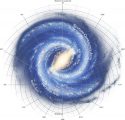 Beyond the orbit of Neptune (the eighth planet) lies a large region of dust, debris, and some large objects. The region is called Kuiper belt which mostly houses material left after the formation of the Solar System. Kuiper belt is much larger than the asteroid belt and extends up to the last boundary of our solar system.
Beyond the orbit of Neptune (the eighth planet) lies a large region of dust, debris, and some large objects. The region is called Kuiper belt which mostly houses material left after the formation of the Solar System. Kuiper belt is much larger than the asteroid belt and extends up to the last boundary of our solar system.
Kuiper belt is also famous for housing many dwarf planets which include Pluto, Makemake, and Eris. Many Comets that have a short orbital period have also been originated from the Kuiper belt.
Composition of the Kuiper Belt
 Kuiper belt has many objects which include dust, comets, asteroids, and dwarf planets. The chemical makeup of smaller objects is very hard to find because the Kuiper belt is very far from the Earth. Scientists mostly use spectroscopy techniques to determine the presence of Elements in these objects.
Kuiper belt has many objects which include dust, comets, asteroids, and dwarf planets. The chemical makeup of smaller objects is very hard to find because the Kuiper belt is very far from the Earth. Scientists mostly use spectroscopy techniques to determine the presence of Elements in these objects.
From the spectroscopic analysis, it was found that most of the material in the Kuiper belt is rocky. Whereas, the presence of water ice, ammonia, and methane was also found.
Structure of the Kuiper Belt
The Kuiper belt cover the distance between 30 AU to 50 AU from the Earth (1 Astronomical Unit = 150 million km). Since the Kuiper belt starts from the orbit of Neptune, so most of the time the Gravity of Neptune interacts with the objects in the Kuiper belt. The interaction of Neptune with the Kuiper belt has caused many gaps of free space in the Kuiper belt. The influence of Neptune also causes some objects to go towards the inner solar system, while others towards interstellar space.
Discovery
After the discovery of Pluto in 1930, scientists have predicted that there might be some other objects beyond Neptune other than the Pluto. But, the technology of that time couldn’t test the idea and the Pluto was placed in the category of planets. But in 1992 things have changed and scientists were able to find other objects that shared their orbit with Pluto. Soon it was realized that the whole region beyond Neptune, the Kuiper Belt, houses many objects similar to Pluto and many other objects.
Facts
- Pioneer 10 spacecraft from NASA became the first to enter in the Kuiper Belt in 1983. It happened before the official recognition of the Kuiper belt itself.
- Many objects in the Kuiper belt have moons that orbit around those objects. Some of these objects are Eris, Pluto, and Haumea.
- When our solar system was young, the total mass of the Kuiper Belt was around 5 times more than the Earth. But, the mass of Kuiper belt has remained at 10% mass of the Earth. This indicates that the Kuiper belt has eroded since its formation.





